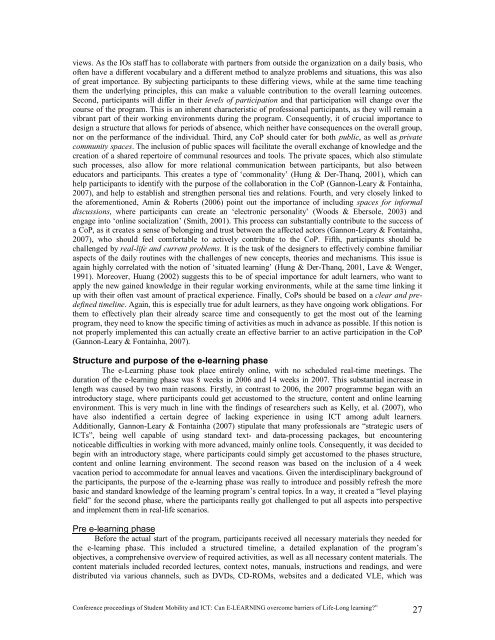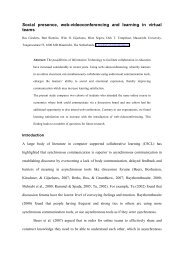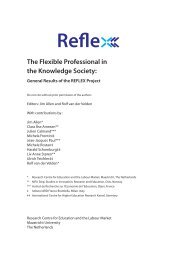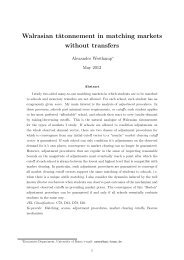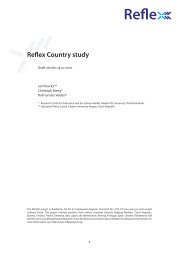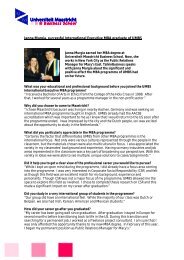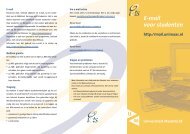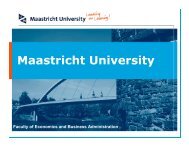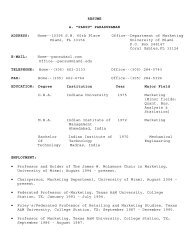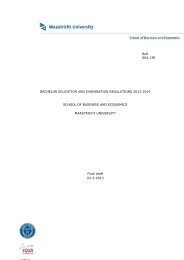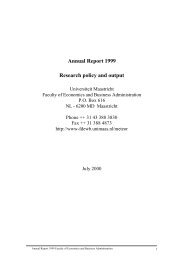proceedings of Student Mobility and ICT: Can E-LEARNING
proceedings of Student Mobility and ICT: Can E-LEARNING
proceedings of Student Mobility and ICT: Can E-LEARNING
You also want an ePaper? Increase the reach of your titles
YUMPU automatically turns print PDFs into web optimized ePapers that Google loves.
views. As the IOs staff has to collaborate with partners from outside the organization on a daily basis, who<br />
<strong>of</strong>ten have a different vocabulary <strong>and</strong> a different method to analyze problems <strong>and</strong> situations, this was also<br />
<strong>of</strong> great importance. By subjecting participants to these differing views, while at the same time teaching<br />
them the underlying principles, this can make a valuable contribution to the overall learning outcomes.<br />
Second, participants will differ in their levels <strong>of</strong> participation <strong>and</strong> that participation will change over the<br />
course <strong>of</strong> the program. This is an inherent characteristic <strong>of</strong> pr<strong>of</strong>essional participants, as they will remain a<br />
vibrant part <strong>of</strong> their working environments during the program. Consequently, it <strong>of</strong> crucial importance to<br />
design a structure that allows for periods <strong>of</strong> absence, which neither have consequences on the overall group,<br />
nor on the performance <strong>of</strong> the individual. Third, any CoP should cater for both public, as well as private<br />
community spaces. The inclusion <strong>of</strong> public spaces will facilitate the overall exchange <strong>of</strong> knowledge <strong>and</strong> the<br />
creation <strong>of</strong> a shared repertoire <strong>of</strong> communal resources <strong>and</strong> tools. The private spaces, which also stimulate<br />
such processes, also allow for more relational communication between participants, but also between<br />
educators <strong>and</strong> participants. This creates a type <strong>of</strong> ‘commonality’ (Hung & Der-Thanq, 2001), which can<br />
help participants to identify with the purpose <strong>of</strong> the collaboration in the CoP (Gannon-Leary & Fontainha,<br />
2007), <strong>and</strong> help to establish <strong>and</strong> strengthen personal ties <strong>and</strong> relations. Fourth, <strong>and</strong> very closely linked to<br />
the aforementioned, Amin & Roberts (2006) point out the importance <strong>of</strong> including spaces for informal<br />
discussions, where participants can create an ‘electronic personality’ (Woods & Ebersole, 2003) <strong>and</strong><br />
engage into ‘online socialization’ (Smith, 2001). This process can substantially contribute to the success <strong>of</strong><br />
a CoP, as it creates a sense <strong>of</strong> belonging <strong>and</strong> trust between the affected actors (Gannon-Leary & Fontainha,<br />
2007), who should feel comfortable to actively contribute to the CoP. Fifth, participants should be<br />
challenged by real-life <strong>and</strong> current problems. It is the task <strong>of</strong> the designers to effectively combine familiar<br />
aspects <strong>of</strong> the daily routines with the challenges <strong>of</strong> new concepts, theories <strong>and</strong> mechanisms. This issue is<br />
again highly correlated with the notion <strong>of</strong> ‘situated learning’ (Hung & Der-Thanq, 2001, Lave & Wenger,<br />
1991). Moreover, Huang (2002) suggests this to be <strong>of</strong> special importance for adult learners, who want to<br />
apply the new gained knowledge in their regular working environments, while at the same time linking it<br />
up with their <strong>of</strong>ten vast amount <strong>of</strong> practical experience. Finally, CoPs should be based on a clear <strong>and</strong> predefined<br />
timeline. Again, this is especially true for adult learners, as they have ongoing work obligations. For<br />
them to effectively plan their already scarce time <strong>and</strong> consequently to get the most out <strong>of</strong> the learning<br />
program, they need to know the specific timing <strong>of</strong> activities as much in advance as possible. If this notion is<br />
not properly implemented this can actually create an effective barrier to an active participation in the CoP<br />
(Gannon-Leary & Fontainha, 2007).<br />
Structure <strong>and</strong> purpose <strong>of</strong> the e-learning phase<br />
The e-Learning phase took place entirely online, with no scheduled real-time meetings. The<br />
duration <strong>of</strong> the e-learning phase was 8 weeks in 2006 <strong>and</strong> 14 weeks in 2007. This substantial increase in<br />
length was caused by two main reasons. Firstly, in contrast to 2006, the 2007 programme began with an<br />
introductory stage, where participants could get accustomed to the structure, content <strong>and</strong> online learning<br />
environment. This is very much in line with the findings <strong>of</strong> researchers such as Kelly, et al. (2007), who<br />
have also indentified a certain degree <strong>of</strong> lacking experience in using <strong>ICT</strong> among adult learners.<br />
Additionally, Gannon-Leary & Fontainha (2007) stipulate that many pr<strong>of</strong>essionals are “strategic users <strong>of</strong><br />
<strong>ICT</strong>s”, being well capable <strong>of</strong> using st<strong>and</strong>ard text- <strong>and</strong> data-processing packages, but encountering<br />
noticeable difficulties in working with more advanced, mainly online tools. Consequently, it was decided to<br />
begin with an introductory stage, where participants could simply get accustomed to the phases structure,<br />
content <strong>and</strong> online learning environment. The second reason was based on the inclusion <strong>of</strong> a 4 week<br />
vacation period to accommodate for annual leaves <strong>and</strong> vacations. Given the interdisciplinary background <strong>of</strong><br />
the participants, the purpose <strong>of</strong> the e-learning phase was really to introduce <strong>and</strong> possibly refresh the more<br />
basic <strong>and</strong> st<strong>and</strong>ard knowledge <strong>of</strong> the learning program’s central topics. In a way, it created a “level playing<br />
field” for the second phase, where the participants really got challenged to put all aspects into perspective<br />
<strong>and</strong> implement them in real-life scenarios.<br />
Pre e-learning phase<br />
Before the actual start <strong>of</strong> the program, participants received all necessary materials they needed for<br />
the e-learning phase. This included a structured timeline, a detailed explanation <strong>of</strong> the program’s<br />
objectives, a comprehensive overview <strong>of</strong> required activities, as well as all necessary content materials. The<br />
content materials included recorded lectures, context notes, manuals, instructions <strong>and</strong> readings, <strong>and</strong> were<br />
distributed via various channels, such as DVDs, CD-ROMs, websites <strong>and</strong> a dedicated VLE, which was<br />
Conference <strong>proceedings</strong> <strong>of</strong> <strong>Student</strong> <strong>Mobility</strong> <strong>and</strong> <strong>ICT</strong>: <strong>Can</strong> E-<strong>LEARNING</strong> overcome barriers <strong>of</strong> Life-Long learning?” 27


